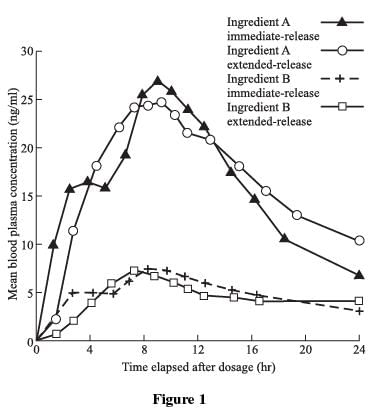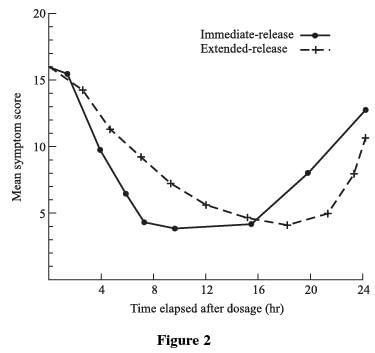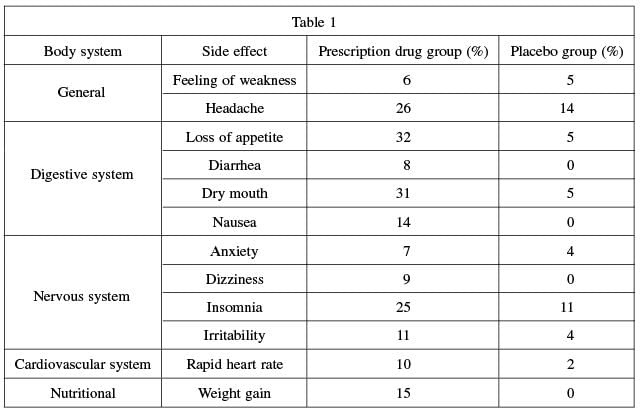ACT Exam > ACT Questions > Directions:Read the passages and choose the b...
Start Learning for Free
Directions: Read the passages and choose the best answer to each question.
Passage
Researchers conducted trials on a certain prescription drug delivered in immediate-release capsules and extendedrelease capsules.
Figure 1 shows the mean concentration (nanograms per milliliter [ng/mL]) of the two active ingredients of the prescription drug in patients’ blood plasma over time (hr).

In clinical trials of the prescription drug, subjects given the prescription drug were interviewed at regular intervals about the symptoms the prescription drug is meant to relieve.
After each interview, the subjects were assigned a symptom score. A high symptom score corresponds to high intensity of symptoms, and a low symptom score indicates low intensity of symptoms. Figure 2 shows the mean symptom score over time (hr) for subjects who took the prescription drug.
In the clinical trials, some subjects were given the prescription drug and some subjects were given a placebo (an inactive pill). Table 1 shows the percentage of subjects from both groups who reported various adverse side effects.


Researchers conducted trials on a certain prescription drug delivered in immediate-release capsules and extendedrelease capsules.
Figure 1 shows the mean concentration (nanograms per milliliter [ng/mL]) of the two active ingredients of the prescription drug in patients’ blood plasma over time (hr).

In clinical trials of the prescription drug, subjects given the prescription drug were interviewed at regular intervals about the symptoms the prescription drug is meant to relieve.
After each interview, the subjects were assigned a symptom score. A high symptom score corresponds to high intensity of symptoms, and a low symptom score indicates low intensity of symptoms. Figure 2 shows the mean symptom score over time (hr) for subjects who took the prescription drug.
In the clinical trials, some subjects were given the prescription drug and some subjects were given a placebo (an inactive pill). Table 1 shows the percentage of subjects from both groups who reported various adverse side effects.


Q. Which of the following conclusions about adverse side effects caused by the prescription drug is consistent with the results shown in Table 1?
- a)Results from the placebo group most question the number of instances of feeling of weakness caused by the prescription drug.
- b)Results from the placebo group most question the number of instances of insomnia caused by the prescription drug.
- c)Results from the placebo group least question the number of instances of anxiety caused by the prescription drug.
- d)Results from the placebo group least question the number of instances of irritability caused by the prescription drug.
Correct answer is option 'A'. Can you explain this answer?
Most Upvoted Answer
Directions:Read the passages and choose the best answer to each questi...
Table 1 shows that nearly as many subjects given the placebo (5%) reported feelings of weakness as did subjects given the drug (6%). The difference of only 1% shows that there is a high level of uncertainty over whether the drug actually caused the feelings of weakness.

|
Explore Courses for ACT exam
|

|
Question Description
Directions:Read the passages and choose the best answer to each question.PassageResearchers conducted trials on a certain prescription drug delivered in immediate-release capsules and extendedrelease capsules.Figure 1 shows the mean concentration (nanograms per milliliter [ng/mL]) of the two active ingredients of the prescription drug in patients’ blood plasma over time (hr).In clinical trials of the prescription drug, subjects given the prescription drug were interviewed at regular intervals about the symptoms the prescription drug is meant to relieve.After each interview, the subjects were assigned a symptom score. A high symptom score corresponds to high intensity of symptoms, and a low symptom score indicates low intensity of symptoms. Figure 2 shows the mean symptom score over time (hr) for subjects who took the prescription drug.In the clinical trials, some subjects were given the prescription drug and some subjects were given a placebo (an inactive pill). Table 1 shows the percentage of subjects from both groups who reported various adverse side effects.Q.Which of the following conclusions about adverse side effects caused by the prescription drug is consistent with the results shown in Table 1?a)Results from the placebo group most question the number of instances of feeling of weakness caused by the prescription drug.b)Results from the placebo group most question the number of instances of insomnia caused by the prescription drug.c)Results from the placebo group least question the number of instances of anxiety caused by the prescription drug.d)Results from the placebo group least question the number of instances of irritability caused by the prescription drug.Correct answer is option 'A'. Can you explain this answer? for ACT 2025 is part of ACT preparation. The Question and answers have been prepared according to the ACT exam syllabus. Information about Directions:Read the passages and choose the best answer to each question.PassageResearchers conducted trials on a certain prescription drug delivered in immediate-release capsules and extendedrelease capsules.Figure 1 shows the mean concentration (nanograms per milliliter [ng/mL]) of the two active ingredients of the prescription drug in patients’ blood plasma over time (hr).In clinical trials of the prescription drug, subjects given the prescription drug were interviewed at regular intervals about the symptoms the prescription drug is meant to relieve.After each interview, the subjects were assigned a symptom score. A high symptom score corresponds to high intensity of symptoms, and a low symptom score indicates low intensity of symptoms. Figure 2 shows the mean symptom score over time (hr) for subjects who took the prescription drug.In the clinical trials, some subjects were given the prescription drug and some subjects were given a placebo (an inactive pill). Table 1 shows the percentage of subjects from both groups who reported various adverse side effects.Q.Which of the following conclusions about adverse side effects caused by the prescription drug is consistent with the results shown in Table 1?a)Results from the placebo group most question the number of instances of feeling of weakness caused by the prescription drug.b)Results from the placebo group most question the number of instances of insomnia caused by the prescription drug.c)Results from the placebo group least question the number of instances of anxiety caused by the prescription drug.d)Results from the placebo group least question the number of instances of irritability caused by the prescription drug.Correct answer is option 'A'. Can you explain this answer? covers all topics & solutions for ACT 2025 Exam. Find important definitions, questions, meanings, examples, exercises and tests below for Directions:Read the passages and choose the best answer to each question.PassageResearchers conducted trials on a certain prescription drug delivered in immediate-release capsules and extendedrelease capsules.Figure 1 shows the mean concentration (nanograms per milliliter [ng/mL]) of the two active ingredients of the prescription drug in patients’ blood plasma over time (hr).In clinical trials of the prescription drug, subjects given the prescription drug were interviewed at regular intervals about the symptoms the prescription drug is meant to relieve.After each interview, the subjects were assigned a symptom score. A high symptom score corresponds to high intensity of symptoms, and a low symptom score indicates low intensity of symptoms. Figure 2 shows the mean symptom score over time (hr) for subjects who took the prescription drug.In the clinical trials, some subjects were given the prescription drug and some subjects were given a placebo (an inactive pill). Table 1 shows the percentage of subjects from both groups who reported various adverse side effects.Q.Which of the following conclusions about adverse side effects caused by the prescription drug is consistent with the results shown in Table 1?a)Results from the placebo group most question the number of instances of feeling of weakness caused by the prescription drug.b)Results from the placebo group most question the number of instances of insomnia caused by the prescription drug.c)Results from the placebo group least question the number of instances of anxiety caused by the prescription drug.d)Results from the placebo group least question the number of instances of irritability caused by the prescription drug.Correct answer is option 'A'. Can you explain this answer?.
Directions:Read the passages and choose the best answer to each question.PassageResearchers conducted trials on a certain prescription drug delivered in immediate-release capsules and extendedrelease capsules.Figure 1 shows the mean concentration (nanograms per milliliter [ng/mL]) of the two active ingredients of the prescription drug in patients’ blood plasma over time (hr).In clinical trials of the prescription drug, subjects given the prescription drug were interviewed at regular intervals about the symptoms the prescription drug is meant to relieve.After each interview, the subjects were assigned a symptom score. A high symptom score corresponds to high intensity of symptoms, and a low symptom score indicates low intensity of symptoms. Figure 2 shows the mean symptom score over time (hr) for subjects who took the prescription drug.In the clinical trials, some subjects were given the prescription drug and some subjects were given a placebo (an inactive pill). Table 1 shows the percentage of subjects from both groups who reported various adverse side effects.Q.Which of the following conclusions about adverse side effects caused by the prescription drug is consistent with the results shown in Table 1?a)Results from the placebo group most question the number of instances of feeling of weakness caused by the prescription drug.b)Results from the placebo group most question the number of instances of insomnia caused by the prescription drug.c)Results from the placebo group least question the number of instances of anxiety caused by the prescription drug.d)Results from the placebo group least question the number of instances of irritability caused by the prescription drug.Correct answer is option 'A'. Can you explain this answer? for ACT 2025 is part of ACT preparation. The Question and answers have been prepared according to the ACT exam syllabus. Information about Directions:Read the passages and choose the best answer to each question.PassageResearchers conducted trials on a certain prescription drug delivered in immediate-release capsules and extendedrelease capsules.Figure 1 shows the mean concentration (nanograms per milliliter [ng/mL]) of the two active ingredients of the prescription drug in patients’ blood plasma over time (hr).In clinical trials of the prescription drug, subjects given the prescription drug were interviewed at regular intervals about the symptoms the prescription drug is meant to relieve.After each interview, the subjects were assigned a symptom score. A high symptom score corresponds to high intensity of symptoms, and a low symptom score indicates low intensity of symptoms. Figure 2 shows the mean symptom score over time (hr) for subjects who took the prescription drug.In the clinical trials, some subjects were given the prescription drug and some subjects were given a placebo (an inactive pill). Table 1 shows the percentage of subjects from both groups who reported various adverse side effects.Q.Which of the following conclusions about adverse side effects caused by the prescription drug is consistent with the results shown in Table 1?a)Results from the placebo group most question the number of instances of feeling of weakness caused by the prescription drug.b)Results from the placebo group most question the number of instances of insomnia caused by the prescription drug.c)Results from the placebo group least question the number of instances of anxiety caused by the prescription drug.d)Results from the placebo group least question the number of instances of irritability caused by the prescription drug.Correct answer is option 'A'. Can you explain this answer? covers all topics & solutions for ACT 2025 Exam. Find important definitions, questions, meanings, examples, exercises and tests below for Directions:Read the passages and choose the best answer to each question.PassageResearchers conducted trials on a certain prescription drug delivered in immediate-release capsules and extendedrelease capsules.Figure 1 shows the mean concentration (nanograms per milliliter [ng/mL]) of the two active ingredients of the prescription drug in patients’ blood plasma over time (hr).In clinical trials of the prescription drug, subjects given the prescription drug were interviewed at regular intervals about the symptoms the prescription drug is meant to relieve.After each interview, the subjects were assigned a symptom score. A high symptom score corresponds to high intensity of symptoms, and a low symptom score indicates low intensity of symptoms. Figure 2 shows the mean symptom score over time (hr) for subjects who took the prescription drug.In the clinical trials, some subjects were given the prescription drug and some subjects were given a placebo (an inactive pill). Table 1 shows the percentage of subjects from both groups who reported various adverse side effects.Q.Which of the following conclusions about adverse side effects caused by the prescription drug is consistent with the results shown in Table 1?a)Results from the placebo group most question the number of instances of feeling of weakness caused by the prescription drug.b)Results from the placebo group most question the number of instances of insomnia caused by the prescription drug.c)Results from the placebo group least question the number of instances of anxiety caused by the prescription drug.d)Results from the placebo group least question the number of instances of irritability caused by the prescription drug.Correct answer is option 'A'. Can you explain this answer?.
Solutions for Directions:Read the passages and choose the best answer to each question.PassageResearchers conducted trials on a certain prescription drug delivered in immediate-release capsules and extendedrelease capsules.Figure 1 shows the mean concentration (nanograms per milliliter [ng/mL]) of the two active ingredients of the prescription drug in patients’ blood plasma over time (hr).In clinical trials of the prescription drug, subjects given the prescription drug were interviewed at regular intervals about the symptoms the prescription drug is meant to relieve.After each interview, the subjects were assigned a symptom score. A high symptom score corresponds to high intensity of symptoms, and a low symptom score indicates low intensity of symptoms. Figure 2 shows the mean symptom score over time (hr) for subjects who took the prescription drug.In the clinical trials, some subjects were given the prescription drug and some subjects were given a placebo (an inactive pill). Table 1 shows the percentage of subjects from both groups who reported various adverse side effects.Q.Which of the following conclusions about adverse side effects caused by the prescription drug is consistent with the results shown in Table 1?a)Results from the placebo group most question the number of instances of feeling of weakness caused by the prescription drug.b)Results from the placebo group most question the number of instances of insomnia caused by the prescription drug.c)Results from the placebo group least question the number of instances of anxiety caused by the prescription drug.d)Results from the placebo group least question the number of instances of irritability caused by the prescription drug.Correct answer is option 'A'. Can you explain this answer? in English & in Hindi are available as part of our courses for ACT.
Download more important topics, notes, lectures and mock test series for ACT Exam by signing up for free.
Here you can find the meaning of Directions:Read the passages and choose the best answer to each question.PassageResearchers conducted trials on a certain prescription drug delivered in immediate-release capsules and extendedrelease capsules.Figure 1 shows the mean concentration (nanograms per milliliter [ng/mL]) of the two active ingredients of the prescription drug in patients’ blood plasma over time (hr).In clinical trials of the prescription drug, subjects given the prescription drug were interviewed at regular intervals about the symptoms the prescription drug is meant to relieve.After each interview, the subjects were assigned a symptom score. A high symptom score corresponds to high intensity of symptoms, and a low symptom score indicates low intensity of symptoms. Figure 2 shows the mean symptom score over time (hr) for subjects who took the prescription drug.In the clinical trials, some subjects were given the prescription drug and some subjects were given a placebo (an inactive pill). Table 1 shows the percentage of subjects from both groups who reported various adverse side effects.Q.Which of the following conclusions about adverse side effects caused by the prescription drug is consistent with the results shown in Table 1?a)Results from the placebo group most question the number of instances of feeling of weakness caused by the prescription drug.b)Results from the placebo group most question the number of instances of insomnia caused by the prescription drug.c)Results from the placebo group least question the number of instances of anxiety caused by the prescription drug.d)Results from the placebo group least question the number of instances of irritability caused by the prescription drug.Correct answer is option 'A'. Can you explain this answer? defined & explained in the simplest way possible. Besides giving the explanation of
Directions:Read the passages and choose the best answer to each question.PassageResearchers conducted trials on a certain prescription drug delivered in immediate-release capsules and extendedrelease capsules.Figure 1 shows the mean concentration (nanograms per milliliter [ng/mL]) of the two active ingredients of the prescription drug in patients’ blood plasma over time (hr).In clinical trials of the prescription drug, subjects given the prescription drug were interviewed at regular intervals about the symptoms the prescription drug is meant to relieve.After each interview, the subjects were assigned a symptom score. A high symptom score corresponds to high intensity of symptoms, and a low symptom score indicates low intensity of symptoms. Figure 2 shows the mean symptom score over time (hr) for subjects who took the prescription drug.In the clinical trials, some subjects were given the prescription drug and some subjects were given a placebo (an inactive pill). Table 1 shows the percentage of subjects from both groups who reported various adverse side effects.Q.Which of the following conclusions about adverse side effects caused by the prescription drug is consistent with the results shown in Table 1?a)Results from the placebo group most question the number of instances of feeling of weakness caused by the prescription drug.b)Results from the placebo group most question the number of instances of insomnia caused by the prescription drug.c)Results from the placebo group least question the number of instances of anxiety caused by the prescription drug.d)Results from the placebo group least question the number of instances of irritability caused by the prescription drug.Correct answer is option 'A'. Can you explain this answer?, a detailed solution for Directions:Read the passages and choose the best answer to each question.PassageResearchers conducted trials on a certain prescription drug delivered in immediate-release capsules and extendedrelease capsules.Figure 1 shows the mean concentration (nanograms per milliliter [ng/mL]) of the two active ingredients of the prescription drug in patients’ blood plasma over time (hr).In clinical trials of the prescription drug, subjects given the prescription drug were interviewed at regular intervals about the symptoms the prescription drug is meant to relieve.After each interview, the subjects were assigned a symptom score. A high symptom score corresponds to high intensity of symptoms, and a low symptom score indicates low intensity of symptoms. Figure 2 shows the mean symptom score over time (hr) for subjects who took the prescription drug.In the clinical trials, some subjects were given the prescription drug and some subjects were given a placebo (an inactive pill). Table 1 shows the percentage of subjects from both groups who reported various adverse side effects.Q.Which of the following conclusions about adverse side effects caused by the prescription drug is consistent with the results shown in Table 1?a)Results from the placebo group most question the number of instances of feeling of weakness caused by the prescription drug.b)Results from the placebo group most question the number of instances of insomnia caused by the prescription drug.c)Results from the placebo group least question the number of instances of anxiety caused by the prescription drug.d)Results from the placebo group least question the number of instances of irritability caused by the prescription drug.Correct answer is option 'A'. Can you explain this answer? has been provided alongside types of Directions:Read the passages and choose the best answer to each question.PassageResearchers conducted trials on a certain prescription drug delivered in immediate-release capsules and extendedrelease capsules.Figure 1 shows the mean concentration (nanograms per milliliter [ng/mL]) of the two active ingredients of the prescription drug in patients’ blood plasma over time (hr).In clinical trials of the prescription drug, subjects given the prescription drug were interviewed at regular intervals about the symptoms the prescription drug is meant to relieve.After each interview, the subjects were assigned a symptom score. A high symptom score corresponds to high intensity of symptoms, and a low symptom score indicates low intensity of symptoms. Figure 2 shows the mean symptom score over time (hr) for subjects who took the prescription drug.In the clinical trials, some subjects were given the prescription drug and some subjects were given a placebo (an inactive pill). Table 1 shows the percentage of subjects from both groups who reported various adverse side effects.Q.Which of the following conclusions about adverse side effects caused by the prescription drug is consistent with the results shown in Table 1?a)Results from the placebo group most question the number of instances of feeling of weakness caused by the prescription drug.b)Results from the placebo group most question the number of instances of insomnia caused by the prescription drug.c)Results from the placebo group least question the number of instances of anxiety caused by the prescription drug.d)Results from the placebo group least question the number of instances of irritability caused by the prescription drug.Correct answer is option 'A'. Can you explain this answer? theory, EduRev gives you an
ample number of questions to practice Directions:Read the passages and choose the best answer to each question.PassageResearchers conducted trials on a certain prescription drug delivered in immediate-release capsules and extendedrelease capsules.Figure 1 shows the mean concentration (nanograms per milliliter [ng/mL]) of the two active ingredients of the prescription drug in patients’ blood plasma over time (hr).In clinical trials of the prescription drug, subjects given the prescription drug were interviewed at regular intervals about the symptoms the prescription drug is meant to relieve.After each interview, the subjects were assigned a symptom score. A high symptom score corresponds to high intensity of symptoms, and a low symptom score indicates low intensity of symptoms. Figure 2 shows the mean symptom score over time (hr) for subjects who took the prescription drug.In the clinical trials, some subjects were given the prescription drug and some subjects were given a placebo (an inactive pill). Table 1 shows the percentage of subjects from both groups who reported various adverse side effects.Q.Which of the following conclusions about adverse side effects caused by the prescription drug is consistent with the results shown in Table 1?a)Results from the placebo group most question the number of instances of feeling of weakness caused by the prescription drug.b)Results from the placebo group most question the number of instances of insomnia caused by the prescription drug.c)Results from the placebo group least question the number of instances of anxiety caused by the prescription drug.d)Results from the placebo group least question the number of instances of irritability caused by the prescription drug.Correct answer is option 'A'. Can you explain this answer? tests, examples and also practice ACT tests.

|
Explore Courses for ACT exam
|

|
Signup for Free!
Signup to see your scores go up within 7 days! Learn & Practice with 1000+ FREE Notes, Videos & Tests.


















